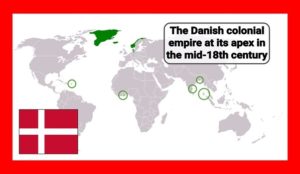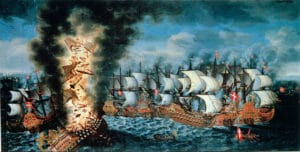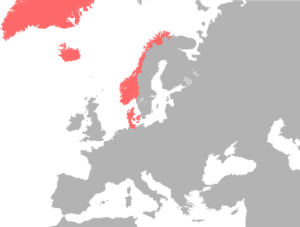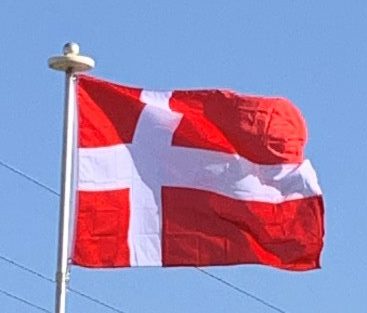
In the Thirty Years’ War, Christian tried to become the leader of the Lutheran states in Germany but suffered a crushing defeat at the Battle of Lutter. The result was that the Catholic army under Albrecht von Wallenstein was able to invade, occupy, and pillage Jutland, forcing Denmark to withdraw from the war. Denmark managed to avoid territorial concessions, but King Gustavus Adolphus’ intervention in Germany was seen as a sign that the military power of Sweden was on the rise while Denmark’s influence in the region was declining. Swedish armies invaded Jutland in 1643 and claimed Scania in 1644.
In the 1645 Treaty of Brømsebro, Denmark surrendered Halland, Gotland, the last parts of Danish Estonia, and several provinces in Norway. In 1657, King Frederick III declared war on Sweden and marched on Bremen-Verden. This led to a massive Danish defeat and the armies of King Charles X Gustav of Sweden conquered Jutland, Funen, and much of Zealand before signing the Peace of Roskilde in February 1658, which gave Sweden control of Scania, Blekinge, Trøndelag, and the island of Bornholm. Charles X Gustav quickly regretted not having ruined Denmark and in August 1658, he began a two-year-long siege of Copenhagen but he failed to take the capital. In the ensuing peace settlement, Denmark managed to maintain its independence and regain control of Trøndelag and Bornholm.
Denmark tried but failed to regain control of Scania in the Scanian War (1675–1679).

After the Great Northern War (1700–21), Denmark managed to regain control of the parts of Schleswig and Holstein ruled by the house of Holstein-Gottorp in the 1720 Treaty of Frederiksborg and the 1773 Treaty of Tsarskoye Selo, respectively. Denmark prospered greatly in the last decades of the 18th century due to its neutral status allowing it to trade with both sides in the many contemporary wars. In the Napoleonic Wars, Denmark traded with both France and the United Kingdom and joined the League of Armed Neutrality with Russia, Sweden, and Prussia. The British considered this a hostile act and attacked Copenhagen in 1801 and 1807, in one case carrying off the Danish fleet, in the other, burning large parts of the Danish capital. This led to the so-called Danish-British Gunboat War. British control of the waterways between Denmark and Norway proved disastrous to the union’s economy and in 1813 Denmark–Norway went bankrupt.

The union was dissolved by the Treaty of Kiel in 1814; the Danish monarchy “irrevocably and forever” renounced claims to the Kingdom of Norway in favor of the Swedish king. Denmark kept the possessions of Iceland (which retained the Danish monarchy until 1944), the Faroe Islands and Greenland, all of which had been governed by Norway for centuries. Apart from the Nordic colonies, Denmark continued to rule over Danish India from 1620 to 1869, the Danish Gold Coast (Ghana) from 1658 to 1850, and the Danish West Indies from 1671 to 1917.
Constitutional Monarchy (1849–Present):
A nascent Danish liberal and national movement gained momentum in the 1830s; after the European Revolutions of 1848, Denmark peacefully became a constitutional monarchy on 5 June 1849. A new constitution established a two-chamber parliament. Denmark faced war against both Prussia and Austrian Empire in what became known as the Second Schleswig War, lasting from February to October 1864. Denmark was defeated and obliged to cede Schleswig and Holstein to Prussia. This loss came as the latest in the long series of defeats and territorial losses that had begun in the 17th century. After these events, Denmark pursued a policy of neutrality in Europe.
